Bloggers are struggling to rank their blogs because they don’t know how to use keywords in blog posts. This article will help them to master the art of using keywords.
SEO and Blogging are becoming the most popular terms among people on digital platforms. And this article is about how to use keywords in blog posts to rank higher on search engines.
Blogging has been the most lucrative business for all levels of business. And you see nowadays that this industry has recorded so many changes when compared to the early 2000s.
Search engines have grown a long way, and it uses artificial intelligence to provide highly relevant results. People’s behavior toward consuming content online has changed a lot.
They use search engines to discover blog content to find a solution or an answer. SEO plays a crucial role in every blogger on earth.
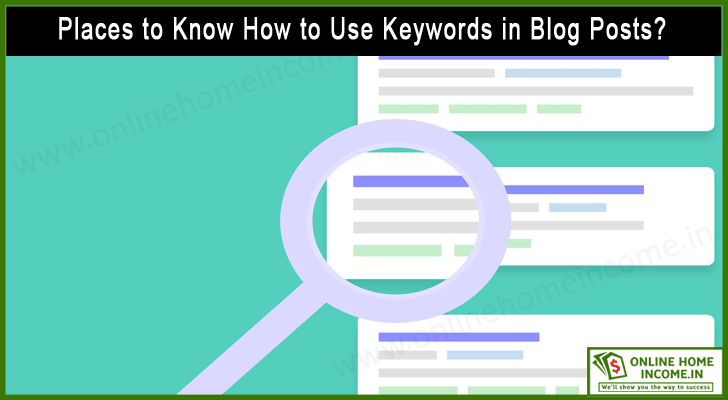
AD
⇒ Online data entry jobs available — Zero Investment, ⇒ Earn Rs 300 to Rs 500 per task, ⇒ https://goo.gl/RcAYw4
⇒ Form Filling Copy Pasting Work — Free registration, ⇒ Earn upto Rs 20000 per month, ⇒ https://goo.gl/RcAYw4
When it comes to optimizing your blog for first-page ranking, knowing where to put keywords in your blog posts is essential.
Thus, bloggers are in a position to use their intelligence in keyword research and find the correct places to add keywords to their blog posts.
Now is the time to redefine your keyword analysis and research in your blog content marketing strategy.
Optimizing your blog posts means that you are increasing the visibility of your blog. If you do not follow the right SEO strategy in every article on the blog, you may not see the expected results.
This article was written for newbies and thriving bloggers to grow their blog audience.
No matter, whether you are a new blogger or writing blogs for many years, having the proper keyword placement knowledge is crucial.
Are Keywords Important for a Blog?
Before answering this question, I want to explain to you how a search engine works. The search engine is basically a software program used to get more relevant results for the user query.
Here, the user inputs a query (or statement) which is referred to as “Keywords”. Search engines use several layers of algorithms to deliver the best results from their database for every user query.
Search engines are the first way-to-go solution provider for people nowadays. People use search engines to search for any or all sorts of things — things like buying decisions on electronic gadgets, planning a journey, etc.
The goal of a search engine like Google is to provide the most relevant and helpful results to the searchers (as quickly as possible).
I hope now you can able to understand the importance of keywords in blogging.
Search engines use keywords to find your blog (from the billions of other blogs on the Internet) and index it onto their database.
Later, based on the user search query, they provide the results.
If you want your blog to get listed in the results, you need to learn how to use keywords in blog posts.
Just writing on a trending topic is not enough to crack the first-page ranking. The proper usage of the keywords also plays a crucial role.
Driving organic traffic is free and available for the long term– that is why every blogger is competing with each other to rank his/her blog.
If you create your blog post easily understandable by Google, then no one can stop you from being a successful blogger.
How to Target Keywords with Blog Posts?
Every blog post that you publish on your blog should be keyword-targeted. Keyword-optimized blog posts can help you in different ways;
- You can get quick attention from search engines and increase the chance of indexing.
- Evergreen (keyword-optimized) content will pull in traffic from search engines for a long time.
Many bloggers fail to make money because they don’t know how to use keywords in blog posts.
You cannot just publish any random content in your blog (It is often seen in many bloggers nowadays).
Bloggers, these days, think that they get traffic and make money just by publishing regular posts.
Moreover, they do not care about strategic keyword research and how it affects their blog content marketing. Here, we will see how to target keywords in your blog posts.
Identify Keyword Opportunities: Before you start writing the next blog post, spend a little time identifying the keyword opportunities. It includes keyword volume, trend, relevancy to your niche, and market demand.
Ask yourself,
- Whether you can add value to your audience?
- Do the keywords have high traffic potential and easy to reach your target audience (Keyword Difficulty)?
Whether those keywords match the user search intent: Ultimately, every blogger wants to rank for the keywords. It is possible only if you know how to use keywords in blog posts that satisfy the user intent.
Now, you start writing SEO-friendly blog posts based on the keyword research report.
Make sure to write long-form posts without keyword stuffing, but add as much information as possible.
If you want to rank your blog post on Google’s first page, you need to tell Google that your content is relevant and helpful.

What Type of Keywords Do I Pick for my Posts?
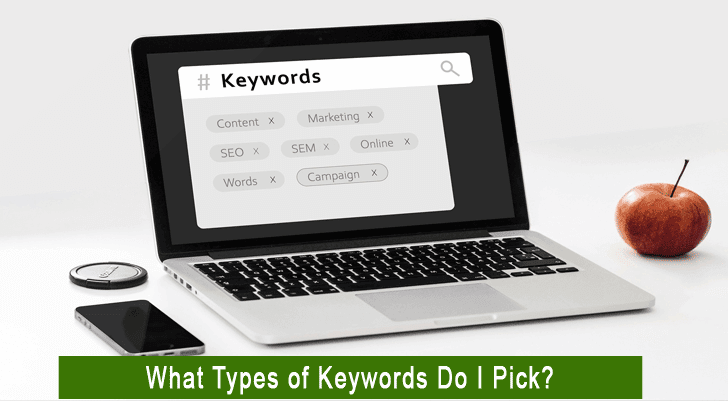
So far, we have studied the importance of how to use keywords in blog posts and how it helps your blog ranking.
If you have some additional time, visit another post on how to find new blog post ideas. Because today most bloggers are struggling to find ideas for their next blog post.
Coming back to the topic, it is not necessary that you can start writing content immediately after the keyword research.
I know that you have the list of keywords, but it does not mean everything. You want to ask a few more questions to narrow down your blogging goal in ranking your blog.
- Does the Keywords Match My Audience Need? Bloggers produce content to help people to solve a problem or find a solution. Hence, knowing your audience is a crucial part of successful blogging. You cannot simply satisfy everyone. You should define your target audience before you enter into this industry.
- See the Keyword Search Volume: You can use a few keyword research tools like Google keyword planner, Ahrefs, and SEMRUSH to get the keyword volume. What’s the use of writing an article for a keyword that does not have a decent search volume (which means no audience)? Therefore, you must need to choose keywords with decent monthly searches.
- Can You Able to Create Content That Aligns with User Intent? Even though you have keywords with you, if you fail to create content that helps people to learn, buy, or take action – you will fail. Therefore, you should evaluate yourself before writing the content around the keywords. Make sure that the content helps people.
7 Best Places on How to Use Keywords in Blog Posts?
Therefore, we have learned the importance of keywords in blog posts. We cannot simply avoid doing Keyword research before writing a blog post.
Keywords are the backbone of your blog, and if you master the art of placing keywords in blog posts, you will win the game.
Since search engines also use keywords as their primary key index, bloggers cannot avoid using them.
Now, we will learn how to use keywords in blog posts. Before going through this, I want to discuss some important keyword classifications.
- Primary Keywords: It is also known as Focus Keyword (or) Target Keyword. It is the main keyword that you are planning to rank for.
- Secondary Keywords: It supports the primary keywords by adding more keyword coverage. In other words, secondary keywords bring in additional information.
- LSI Keywords: Latent Semantic Indexing is primarily related to the Focus keywords and carries synonymic meaning. It means identical context with different words (mainly used to avoid Keyword Stuffing).
- Long-tail Keywords: These keywords usually have more than three or four words and have less search volume.
Now, continue reading how to use keywords in blog posts and know the best places to put keywords.
I use the WordPress Platform for my Blogging Business
In the next part of this article, I use the WordPress platform to show examples. People use other platforms for blogging– like Blogger and Ghost, and some people do custom coding.
However, WordPress is the proven best blogging platform for all. Read the post about WordPress vs Blogger to gain some idea of Why I Insist on WordPress as a blogging platform.
1. Use Primary Keywords in Meta-title, Page-Title (or) H1
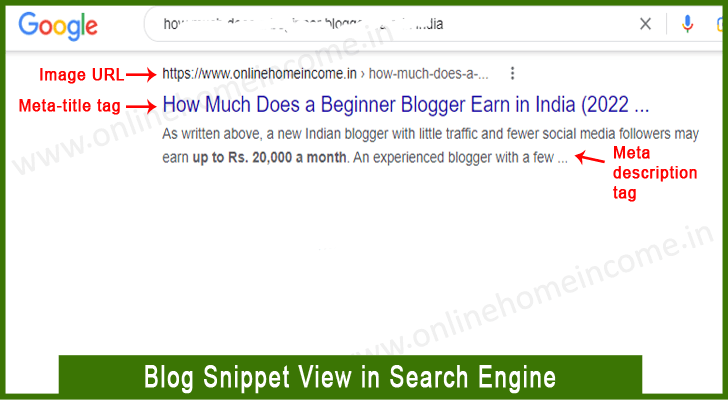
As you all know that you want to write a blog post for two – one is for the people, and the other is for search engine bots. The meta title is the most critical part of SEO for blogs.
The meta title is the text that appears on the SERP pages and tells the topic of the webpage. Search engines pay much attention to the title tags when indexing a blog post for keywords.
The meta title is the most visible part of your blog on the search engine result page.
Your blog’s success or failure is determined by how well you optimize the blog post title by using proper keywords.
Keyword-optimized meta titles will increase the click-through ratio on the SERP pages.
Page-title or H1 serves the same purpose as the meta title, but it is visible to Humans and usually present inside the body of the content.
The page title is usually wrapped between the HTML attributes. Sometimes, you can use the same content for the meta title and page title.
The title tags contribute the maximum percentage in the SEO optimization process. It may either break you or make you grow like anything.
Here’s what you need to do before using keywords in the meta title;
- Use Focus Keyword at the beginning of the title.
- Try to add more keywords either in the first -3- or the last -3- words of the title.
- The character length of the meta title should not go over 60.
- There should only be one meta title and page title (or H1).
So, pay more attention to your Title tags.
2. Place Keywords in Meta Description

It is a short description of 160 characters long that describes the whole article’s context in one or two sentences.
A meta description is otherwise called an article summary that describes the concept or the purpose of your blog posts.
Using the primary focus keyword in the meta description is a powerful way to signal the search engines that help improve the ranking.
It is usually placed under the meta title in the search engine result pages. Here, you can use secondary keywords (or) LSI keywords to describe what you are going to present in the 2500+ words long content.
Write a clear and convincing description to let people click your link shown on the SERP pages. Nowadays, search engine bots fetch their own meta description based on relevancy and other SEO factors.
However, as an SEO content writer, you have to write a meta description as per the Google algorithm.
If you are using WordPress, you can use plugins like Yoast SEO, Rankmath, or All-in-one SEO to add a meta description.
Here’s what you need to do before using keywords in the meta description;
- Maintain the length between 150 – 160 characters long and incorporate the primary keywords only one time.
- Create a helpful, enticing meta description and avoid keyword stuffing by using LSI keywords instead.
- Putting secondary keywords along with one instance of the primary keyword gives more power in SEO.
3. Use Focus Keywords in the Blog Post URL
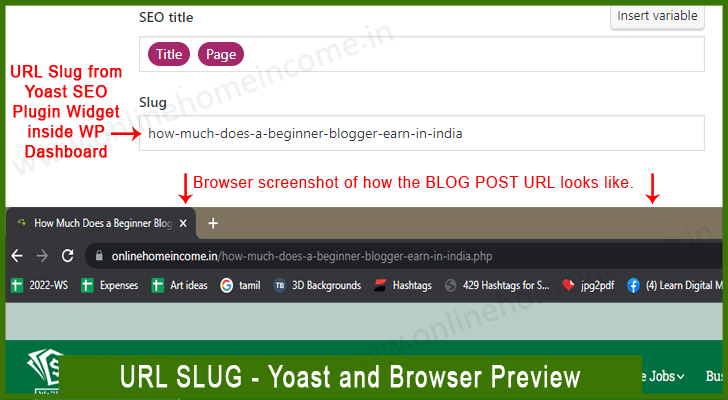
URL (Uniform Resource Locator) is the unique address to find your blog post on the Internet. You need to add a URL slug at the end of your domain name followed by the trailing slash.
The URL slug Is a hyphen-separated phrase that carries the unique web address for your blog posts.
You need to add the Focus Keyword in the blog post URL. It should be short and simple and must convey the message to the users.
Search engines also read the URL and compare its relevancy with your blog content before indexing. Avoid using many keywords, or else you will get a penalty.
Creating a human-readable URL is a good SEO strategy because it helps visitors to remember your content.
Therefore, make your URL looks informative, descriptive, and relatable to the blog topic.
Here’s what you need to do before using keywords in the Blog Post URL;
Include the focus keyword once at the beginning of the URL. Add naturally to avoid any consequences.
Write short URLs to help readers to remember the URL.
Make sure to add all the necessary information for the readers to make a quick decision.
Usually, we can use the meta title hyphenated between the words and in a smaller case.
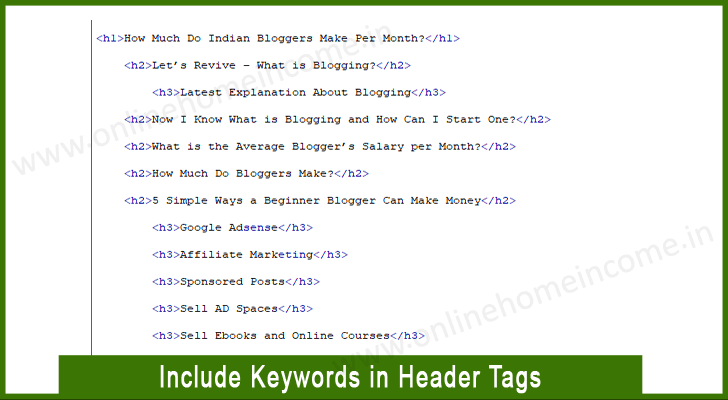
In this article on how to use keywords in blog posts, now, we will see the most prominent location – Header Tags. Header Tags are usually denoted by H1, H2, H3, H4, H5, and H6.
These tags are used to separate long paragraphs. Adding header tags makes it easier for readers to consume your content.
Nowadays, visitors are not spending a long time reading the entire article. Instead, they just glance at the article only by reading the headings to figure out the necessary parts to read.
Search engines also insist to create sub-topics by placing header tags at the appropriate places.
Search engine bots analyze every header tag to increase the chance of a relevant indexing process.
Here’s what you need to do before using keywords in header tags;
- Use focus keywords once every four header tags.
- Place the combination of secondary keywords and LSI keywords in every heading.
- Do not overdo it. Do not try to play smart with search engines.
- Make sure to fit the keywords naturally in the header tags.
5. IMAGE SEO: Add Keywords in Image Alt Tags and Image Name
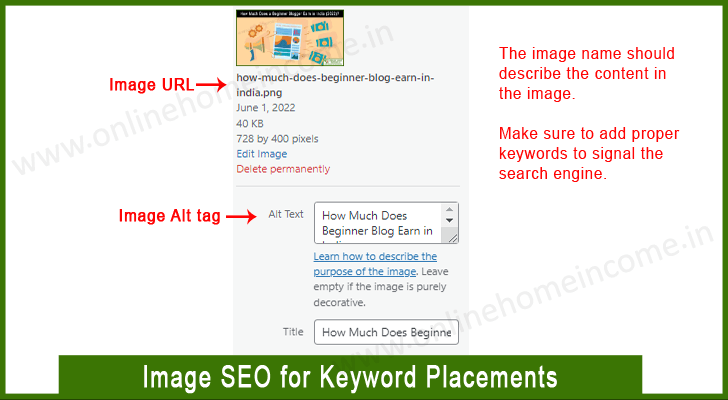
Adding media to the blog articles makes your content more interesting to read.
You can add images (pictures, screenshots, visual statistics, photos, and infographics) and videos to your content to provide more value to the visitors.
When you add images, include the focus keywords in the image name and alt-text. Follow the same strategy that you use for creating the blog post URL structure.
Alt text is the phrase that tells browsers to display the text content if the image is broken (or unable to show). Search engines use this alt-text to learn the content inside the image.
Here’s what you need to do before using keywords in images;
- Use focus keywords in the featured image name and alt-text.
- For other images, you can use a combination of secondary keywords and LSI keywords.
- Again, do not add more keywords (avoid keyword stuffing), and ensure it looks natural.
- The image name should describe the image and should not lead the readers in the wrong way.
- Keywords in the images also count the total keyword density
6. Use Keywords in Paragraphs
The next place to put keywords in blog posts to maximize SEO is your blog content. So far, you have placed keywords in important locations like Meta tags, Header tags, and Images.
Now, you have to add the focus keywords throughout the content naturally. It will send an additional signal to the search engines and tell that the content is related to your topic.
Keyword stuffing is another major concern. So use secondary keywords, LSI keywords, and Long-tail keywords for the maximum SEO benefit.
Forming a keyword cluster helps make your content stand out from the competition. That doesn’t mean that you should focus only on adding keywords.
Keep your audience in mind when writing a blog post. Using keywords will help search engines to understand your context and support indexing.
Whereas, if the post fails to satisfy the searcher’s intent or if they find it not interesting and helpful, all your SEO efforts will become useless.
Slowly, the search engines start to degrade your blog ranking.
Here’s what you need to do before using keywords in the content;
- Maintain a keyword density of 2.5% over the blog content.
- Add the focus keyword on the first 100 words and the last 100 words of the blog content.
- Make sure to include Focus Keyword once in every 500 words.
- To avoid keyword stuffing problems, use secondary and LSI keywords more often.
7. Put Keywords in Anchor Text (Internal Linking)
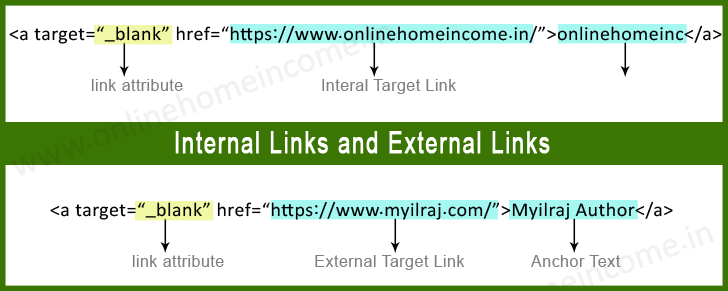
Internal Linking helps link your other relevant blog posts to provide maximum information on the topic. It is also known as Hyperlinks that connect various articles under the same domain name.
Google uses an Internal Link structure to navigate other blog posts and index them. It is the key to gaining a better organic ranking in Google and other search engines.
We use Anchor Text to link other articles that are already published on our blog. Anchor text is the clickable hyperlinked text linking other articles usually created to add more value to the readers.
You should learn how to use keywords in blog posts’ anchor text to maximize your blog SEO.
Internal linking makes your site visitors stay for a long time consuming several additional pieces of information.
It contributes to high user on-time which is a good ranking signal, and it also helps search engines to get a good understanding of your blog topic.
Here’s what you need to do before using keywords in Internal Links;
- Do not use the focus keywords in the anchor text linking to other articles. It will dilute your page authority and creates a keyword cannibalization issue.
- You may LSI keywords for better Internal link structure.
- There is a myth that Google crawls only the first 100 links, but I don’t know how true is that.
- However, limit yourself to a maximum of 2 to 3 internal links between every 500 words.
The primary goal is to make your visitors stay longer on your blog.
Finally, How Many Keywords are for SEO?
I hope, now you have a clear idea of how to use keywords in blog posts for maximum SEO. Below is the key observation from this article how many keywords for SEO?
Bloggers may use up to 8 keywords in Total for every blog post that they publish. Assuming the content length is between 2500 to 3000 words long.
These -8- keywords are further divided as follows;
- 1 primary keyword
- 3 – 4 secondary keywords
- 2 – 3 LSI keywords
Mapping keywords in such a way helps you fight the competition and increase the chance of winning the first-page position.
So, go check your old articles and re-optimize the content to improve your blog SEO. If the blog post length goes beyond 3000 words, you may follow the simple formula.
- Use 1 primary keyword every 500 words.
- Use 1 – 2 secondary keywords every 500 words.
- Use 1 – 2 LSI keywords every 1000 words.
Disclaimer: It is just my assumption, and the results may vary based on the use case. For better results, focus on writing quality and informative content for the people. Understand the searcher’s intent and help them find a solution or solve a problem.
Finally, Where to Put Keywords in Your Blog Posts?
When talking about keyword usage in blog posts, follow the below guidelines. Do not forget about the fundamentals of SEO when it comes to adding keywords to your blog posts.
Go back and check your published posts once. Re-optimize them if you are struggling with ranking.
Primary Keyword
- Use once in the meta title, page title (or) H1, and meta description.
- Use once in Featured Image Name and Alt-tag.
- Use once in the first 100 words and the last 100 words of the article.
- Use once in every 500 – 600 words inside the content.
Secondary Keywords
- Use once in the meta description.
- Use once in every alternate Header Tag (may vary based on the use case).
- Use twice in every 500 – 600 words inside the content.
- Use in other Images (image name and alt tags).
LSI Keyword(s)
- Use once in the meta description (as an alternative to secondary keywords).
- If it sounds over-optimized when using the combination of primary and secondary keywords – use LSI keywords.
- Use once in every 300 words (it helps your readers to stay on the topic) and avoid keyword stuffing.
Warning: Avoid Keyword Stuffing
The goal of this article is to educate bloggers on how to use keywords in blog posts to improve the chance of organic ranking. Don’t take it the wrong way to manipulate search engines.
- Every piece of knowledge has two sides – good and bad.
Search engines like Google are much smarter these years and can tell easily if you are stuffing keywords for SEO. Always keep your readers in mind when writing articles and try to make them feel comfortable while reading.
- The goal is to help the community gain and not to manipulate the system for individual gains.
The above calculation (or) tips are from my knowledge gained after several A/B tests conducted on various blogs. It may or may not get you the same results.
Conclusion
Every blogger on earth who blog has only one primary goal, and that is to create a long-term passive income.
When I started blogging in 2013, I do not have a proper idea about my future. But, today I am a full-time blogger running -5- successful blogs and also helping others to create their blogging business.
Blogging success is defined by the volume of quality content that you publish and the traffic from the search engines.
To meet the goal, you just need to write SEO-friendly blog posts. Optimizing an article for SEO is a daunting process.
But you can do it easily with a little guidance. To achieve this, you must learn how to use keywords in blog posts and implement them in the blog content.
Writing and publishing content is one part of SEO, whereas, adding keywords that tell search engines is a major breakthrough.
Once you figured out how to put keywords in different places on your blog posts, you can easily beat your competitors and rank higher.